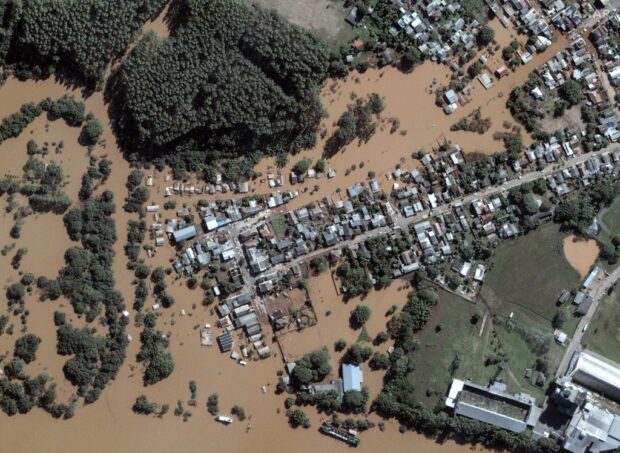Brazilians queue for precious water as flood damage intensifies

Flood evacuees queue to get water at the Humaita neighbourhood in Porto Alegre, Rio Grande do Sul state, Brazil, on May 7, 2024. Since the unprecedented deluge started last week, at least 85 people have died and more than 150,000 were ejected from their homes by floods and mudslides in Rio Grande do Sul state, authorities said. (Photo by NELSON ALMEIDA / AFP)
Porto Alegre, Brazil — Teams scurried on Tuesday to deliver humanitarian aid in Porto Alegre and other flood-ravaged municipalities in southern Brazil, where queues formed for drinking water as forecasters warned of more downpours.
The worst natural calamity ever to hit the state of Rio Grande do Sul has claimed at least 90 lives, with 362 people reported injured and 131 still missing, according to the civil defense force that handles disaster relief.
Nearly 400 municipalities have been hit, including state capital Porto Alegre, and more than 156,000 people have been forced to leave their homes as streets were transformed into rivers after days of record-breaking rain.
READ: Floods in southern Brazil force 70,000 from homes
Porto Alegre is home to some 1.4 million people and the larger metropolitan area has more than double that number.
For tens of thousands of people stranded by impassable roads, collapsed bridges and flooded homes in Rio Grande do Sul, “the most urgent demand is (drinking) water,” said civil defense official Sabrina Ribas.
Helicopters were flying to and fro delivering water and food to communities most in need, while work continued on restoring road access.
In the municipality of Alvorada, east of Porto Alegre, there were queues of people with buckets and plastic bottles, collecting drinking water from the few taps still working.
Most shops have run out of bottled water.
“This is horrible. We have children,” said 27-year-old Gabriela Almeida, queuing at a public tap with a one-year-old in her arms.
Individuals and businesses with wells were doing what they could to help.
READ: Floods in southern Brazil kill at least 75 people, 103 others missing
Alvorada resident Benildo Carvalho, 48, was one of them — filling neighbors’ bottles with a hose as a line of people started to form outside his house.
“It’s a matter of solidarity,” he told AFP. “You cannot deny people water.”
Only two of Porto Alegre’s six water treatment plants were functioning, the mayor’s office said, and hospitals and shelters were being supplied by tankers.
The Brazilian Navy said it would send its “Atlantic” vessel — Latin America’s largest — to Rio Grande do Sul on Wednesday with two mobile water treatment stations.

This handout satellite image courtesy of Maxar Technologies taken on May 7, 2024 shows the Taquari river after floodings in Taquari, Rio Grande do Sul state, Brazil. Since the unprecedented deluge started last week, at least 85 people have died and more than 150,000 were ejected from their homes by floods and mudslides in Rio Grande do Sul state, authorities said. (Photo by Handout / Satellite image ©2024 Maxar Technologies / AFP)
‘Changed the map’
President Luiz Inacio Lula da Silva said more emergency funds would be freed up Tuesday, vowing there would be “no lack of resources to meet the needs of Rio Grande do Sul.”
Some 15,000 soldiers, firefighters, police and volunteers were hard at work in planes and boats, even jet skis, to rescue those trapped and transport aid.
Brazil’s neighbors Uruguay and Argentina have sent rescue equipment and trained personnel.
Celebrities were also doing their part. Footballer Neymar sent a plane with donations and said on Instagram he was “praying for everything to return to normal.”
As the calamity showed no signs of abating, weather forecasts suggested it could still get worse.
The Inmet meteorological institute warned of possible storms in the south of Rio Grande do Sul until Wednesday, followed by rainfall in the center and north which it said would imperil the rescue effort.
The state’s Guaiba River, which runs through Porto Alegre, remained at historic high levels Tuesday, and officials said five dams were at risk of rupturing.
According to weather agency MetSul, the flooding has “changed the map of the metropolitan region” of Porto Alegre.
Lula warned that if harvests are delayed by the flooding in this deeply agricultural region, the country “will have to import rice and beans.”
Police, meanwhile, said there have been reports of evacuated homes being looted and some residents, afraid of such intrusions, were refusing to move to shelters.